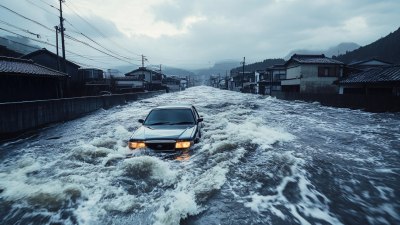Visiting Japan During Typhoon Season: What to Expect and How to Prepare
Learn what to expect and how to prepare for a trip to Japan during typhoon season.

Japan, a nation known for its stunning landscapes, rich history, and unique culture, draws millions of tourists every year. However, those planning a trip to Japan from June to November must be aware that this period coincides with the country's typhoon season. Typhoons are powerful storms that can bring heavy rains and strong winds, leading to travel disruptions. This article aims to provide valuable insights on what travelers can expect during typhoon season in Japan, along with practical tips on how to prepare for a visit during this time.
Understanding Typhoon Season in Japan
The typhoon season in Japan primarily runs from June through November, with the peak months being August and September. Although typhoons can occur at any time during this period, they are more frequent during the late summer months. The Japan Meteorological Agency (JMA) monitors weather patterns, providing timely updates about typhoons and their paths. Commonly referred to as 'tropical cyclones,' typhoons can have significant impacts ranging from heavy rainfall and flooding to landslides, especially in vulnerable areas.
Weather Characteristics
During the typhoon season, travelers can expect a combination of hot and humid weather, particularly in the earlier months. Average temperatures can range from 25°C to 35°C (77°F to 95°F), making it essential for tourists to stay hydrated and dress appropriately. When a typhoon approaches, conditions can change rapidly, with winds picking up and rain intensifying significantly. It is advisable to keep an eye on local weather reports and heed any warnings, especially if you plan to remain in coastal areas.
Travel Disruptions
Typhoon season can lead to various travel disruptions. Flights may be canceled or delayed, and trains can be temporarily suspended, particularly in regions directly threatened by the storm. Cities like Tokyo and Osaka have efficient public transportation systems; however, during severe weather, even the best systems can falter. It's essential to be flexible with your travel plans and have contingency arrangements ready, including alternative routes or accommodation. Always confirm your travel arrangements before heading to the airport or train station.
Safety Measures
When visiting Japan during typhoon season, prioritize safety over all else. Familiarize yourself with the local emergency procedures and evacuation routes, especially if you are staying in areas prone to flooding and landslides. Keep emergency contact numbers handy, and download relevant apps or alerts from the JMA for real-time updates on weather warnings. Keeping a basic emergency kit in your accommodation, including water, snacks, a flashlight, and a first-aid kit, is also advisable.
Packing Tips
To prepare for your trip during typhoon season, it's critical to pack wisely. Light, breathable clothing is essential due to the warm humidity. However, packing a waterproof jacket, sturdy shoes, and an umbrella will significantly help during the intense rain. Waterproof bags or pouches can protect your electronic devices from moisture. Don't forget to bring a portable battery charger, as power outages can happen during storms. Having a few snacks on hand can also be beneficial in case you find yourself unable to venture outside during severe weather.
Indoor Activities
Although typhoon disruptions can put a damper on outdoor activities, Japan offers a wealth of indoor attractions. Museums, aquariums, and shopping complexes provide excellent alternatives to outdoor sightseeing. When heavy rain falls, consider visiting iconic destinations such as the Tokyo National Museum, the Kyoto National Museum, or various art galleries. Ayami Oyatsu, a popular Japanese snack, can also be sought at numerous konbini (convenience stores) to enjoy while staying indoors. Cultural centers or workshops can also be a great choice for travelers looking to immerse themselves in Japanese traditional arts.
Dining and Cuisine
Japan's culinary scene is diverse and delicious, making it a key highlight for any visitor. During typhoon season, many restaurants remain open, although some may adapt their hours or services. It is advisable to call ahead to confirm availability or check online for potential service changes. Traditional izakayas, ramen shops, and sushi bars often provide an authentic dining experience, even during inclement weather. Be sure to try local seasonal dishes and flavors unique to the region you are visiting.
What to Avoid
During typhoon season, certain outdoor activities should be avoided. Hiking and visiting coastal regions can be particularly dangerous due to the risk of flash floods, landslides, and strong currents. It is advisable to steer clear of remote or mountainous areas during such weather. Always check local advisories before planning outdoor excursions, and consider spending time in urban areas where activities and attractions are more sheltered and accessible even during storms.
Connectivity and Communication
Staying connected during a typhoon is essential for both safety and convenience. Investing in a portable Wi-Fi device or SIM card will help you access up-to-date information regarding weather conditions and travel updates. Many apps provide real-time weather forecasts, and having access to your hotel or accommodation's contact information can be a lifesaver if you need to change your plans. Be sure to inform family or friends about your whereabouts in case of emergencies.
Visiting Japan during typhoon season can present unique challenges, but with adequate preparation and flexibility, it can also offer an opportunity to experience the country in a different light. By staying informed about weather conditions, prioritizing safety, and making smart travel choices, you can enjoy your trip even during adverse weather. Embrace the culture, savor the flavors, and take in the sights – all of which remain accessible even when the storms pass. With these tips in hand, you'll be ready to navigate your Japan adventure through and beyond typhoon season.











